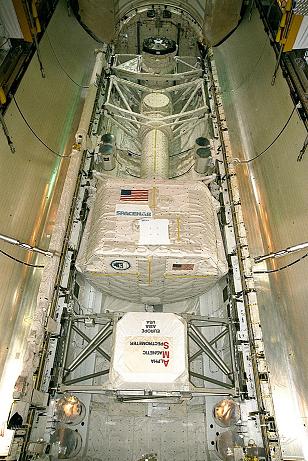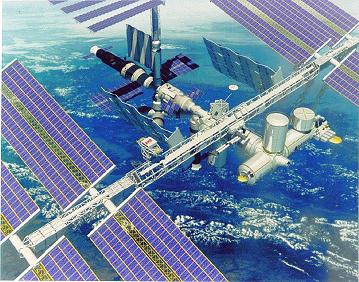The Alpha Magnetic Spectrometer (AMS) is a high-energy particle detector. AMS will detect electrons, positrons, protons, antiprotons, and nuclei in cosmic radiation.
AMS is a cooperative project that involved more than 200 scientists from 31 institutions and 15 countries. The data gathered by AMS during its three-year mission will help scientists answer important questions about antimatter and invisible mass in the Universe. AMS could detect many types of particles predicted by theorists and determine their astrophysical sources.
AMS could reveal to scientists unusual astrophysical objects like antimatter galaxies, dark matter, strangelets, microquasars, and primordial black holes.
AMS actually refers to two particle experiments: AMS-01 and AMS-02. AMS-01 flew in low Earth orbit (LEO) with Space Shuttle Discovery STS-91 in June 1998. AMS-01 was an AMS prototype (a simplified version of the spectrometer) and was used to test particle physics technology in LEO. AMS-02 is the Alpha Magnetic Spectrometer designed to be mounted and operated on the ISS.
AMS-02 is a cube-shaped structure with a mass of 6,731 kg. The spectrometer consists of a huge superconducting magnet and six specialized detectors, and requires 2,000 watts of power.
The experiment has a 10Gb/sec internal data pipeline and will have a dedicated 2MB/sec connection to ground stations. AMS-02 will gather approximately 200 TB of scientific data during its mission. Four 750 MHz PowerPC computers running Linux will provide the computing power.
The spectrometer also contains two star tracker cameras, which detect the orientation in space, and a thermal control system that will control the temperature of the whole experiment. The thermal control system is quite complex. Heat is collected from the detectors and the magnet, and then pushed through conductors to the radiators mounted on the outside of the AMS and radiated into space.
AMS-02 has a little bit of history associated with it … due to the Space Shuttle accidents, which reduced the number of orbiters available, and the decision to retire the Space Shuttle fleet, AMS-02 faced cancellation (a long list of elements meant to be part of the ISS were cancelled for the same reasons). Because an additional shuttle flight was added to the launch manifest, most likely AMS-02 will make it to the space station.
The plan for AMS-02 is that it will be attached to the zenith side of the S3 section of the Integrated Truss Structure on the ISS. A Payload Attachment System will be used to keep the spectrometer in place on the truss segment.
According to the missions schedule, AMS-02 will be installed on ISS as part of the Space Shuttle Discovery STS-134 mission, together with the last ExPRESS Logistics Carrier (ELC-4), in late 2010.
STS-134 will be the last Space Shuttle flight before the deadline set to end Space Shuttle operations on September 30, 2010.
To make things more interesting (and Space Shuttle operations cheaper), it has been proposed that the last mission should end through a destructive re-entry. In this scenario, the reduced crew of three will remain on the space station and return to Earth onboard Soyuz spacecraft.
You can read more about AMS-02 on a dedicated web page at MIT. There is also a web page dedicated to AMS-02 at CERN.












 Subscribe to our RSS feed
Subscribe to our RSS feed











[…] One element that may or may not make it to the ISS is the Alpha Magnetic Spectrometer, an instrument meant to be used to study high energy partcles from cosmic space. DJ at Orbital Hub gives us some detailed background on the project in ‘One Last Chance For The Alpha Magnetic Spectrometer‘. […]
Good story, though if the debate holds, AMS will never detect antimatter. The reason is because of a newly advanced cosmologic model’s central hypothesis of gravitational repulsion between matter and antimatter. Because AMS is a large matter-based object & because gravitational affects to space-time are felt over vast distances, the presence of AMS will cause any antimatter that “would” have past through that space to veer off and never be detected. The important parts of the new Dominium model are summarized on http://www.hasanuddin.org
Alternatively, the new model is being slowly unfolded beginning w/ the first step of the model and then debated on http://www.scientificconcerns.com/Forums/viewtopic.php?f=32&t=776 Please feel free to weigh-in on either side
Add A Comment